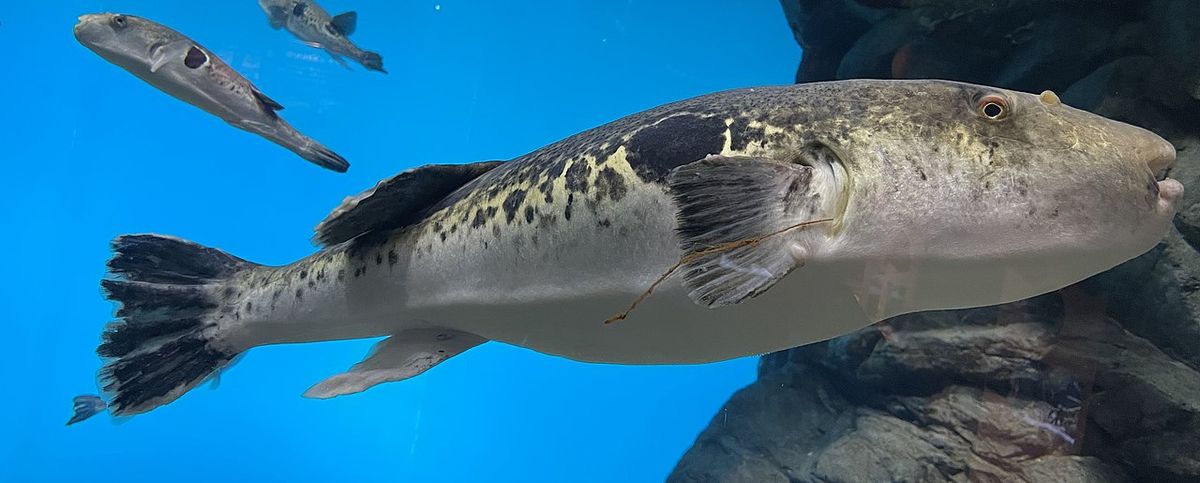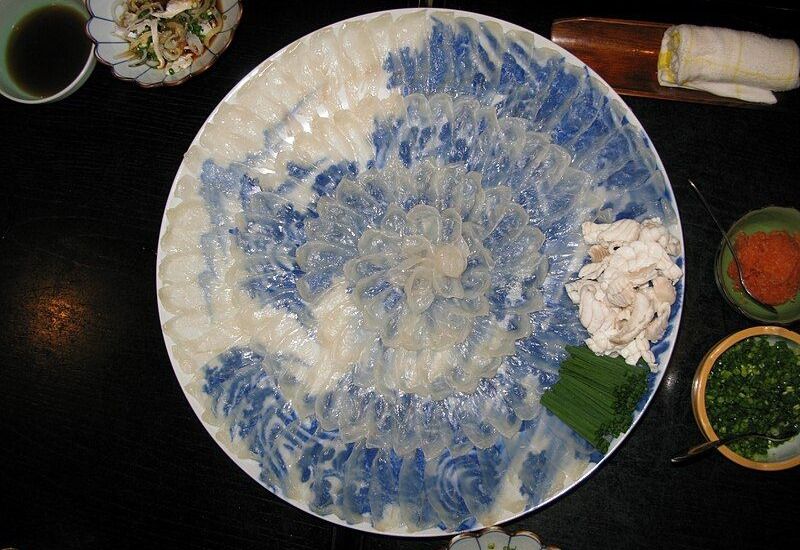Fugu Pufferfish: Here's Why It's So Expensive
Fugu's unique flavor and cultural significance make it a coveted Japanese delicacy, despite its deadly potential and premium cost.

Fugu, fondly called by the locals, is a Japanese culinary gem. With a luxury price tag of $200 per pound, it's the pinnacle of seafood delicacies. Often can be seen in Haedomari market in Shimonoseki for Fugu auction as well.
Expertly prepared, it's a feast unlike any other. However, a tiny mistake in its preparation can be dire for the diner.
What is Fugu?
Fugu, scientifically known as Takifugu rubripes, is a treasured delicacy in Japan, where it is also referred to as torafugu or tiger fugu.
It is also commonly known as the blowfish or pufferfish. This fish is not only famed for its unique culinary flavor but also for the inherent danger associated with its consumption
Containing the potent neurotoxin tetrodotoxin, especially in its liver and ovaries, this fish can prove deadly if even trace amounts are ingested.

Fugu's Food Culture History in Japan
Originating from the Sea of Japan, fugu has been a part of Japanese culinary culture since the ancient Jomon period, around 10,000 BC.
Although its consumption faced a hiatus between the 1600s and 1800s due to poisoning incidents among samurai, it made a triumphant return during the Meiji era.
Since then, fugu has been revered as a gourmet delicacy, with its preparation entrusted only to the most skilled chefs, highlighting its deep-rooted significance in Japan's food history.
Fugu auctions are often held at Haedomari Market in Shimonoseki.
Why is Fugu so Expensive?
Fugu, a prized pufferfish delicacy in Japan, carries a premium price tag $200 per pound due to several factors.
Its inherent tetrodotoxin, a lethal poison, necessitates meticulous preparation by highly trained and licensed chefs.
A primary driver of its cost is the dwindling availability in the market, largely because of overfishing.
The tiger pufferfish, as an example, is now critically endangered due to excessive fishing, leading to strict regulations by the Japanese government in 2005.
Similarly, the population of the popular Chinese pufferfish in Japan has declined by over 99% within the last 45 years, marking it as another critically endangered species.
Although there are more affordable farm-raised fugu options available, they're not only hard to rear but also lack the authentic taste cherished by Japanese aficionados, making the wild variety more sought-after.
The combination of strict safety measures, reduced supply from overfishing, and the pursuit of genuine flavor explains the high cost of fugu.
Which Parts of Fugu is Poisonous?
The fugu, is infamous for its dangerous toxins present in parts like the skin, gills, heart, kidneys, eyes, and especially, the liver, which is the most lethal.
To handle and prepare this fish, specialized training is crucial, more so because the level of toxicity can differ between species.
The appearance of hybrid variants has added to the complexity of distinguishing these species.
Notably, discerning between the toxic ovaries of the female and the edible testicles (Shirako) of the male — a sought-after delicacy — is a significant challenge.
Why Do People Crave the Thrill of Eating Potentially Deadly Fugu?
Despite the inherent risks, fugu is a prized delicacy, especially in Japan, due to its distinctive flavor and texture.
This unique gastronomic experience is a harmonious blend of subtle taste and delicate mouthfeel.
Some liken fugu's taste to chicken, but dedicated connoisseurs claimed that the fish's protein-rich white flesh offers a gentle umami taste with a touch of sweetness.
The allure is not just in its taste; its premium price and the thrill of consuming something so dangerous make it a symbol of luxury and boldness.
The confidence in eating fugu is further heightened by Japan's strict chef training and regulations.
Additionally, its long-standing history in Japanese culture and the slight tingling sensation, believed to be from trace toxin amounts, add to its appeal.
Cuisine of the Fugu Season
Japan's top spots for wild pufferfish are Fukuoka, Yamaguchi, and Shimane. Meanwhile, 60% of farmed pufferfish hail from Nagasaki.
The prime time to enjoy fugu is from October to March, with the fish at their plumpest between December and February due to the cold season.
This esteemed fish is a staple in diverse Japanese culinary spots, from dedicated fugu joints to the conventional kappo and the elite ryotei dining experiences.
How Fugu is Served in Michelin-Starred Restaurants

Fugusashi (Usuzukuri): The art of fugu sashimi is magnified in the thinly-sliced usuzukuri style. Expert artisans, using specialized knives, present slices so thin that the plate's design shows through.
These pieces often resemble chrysanthemums, peonies, or cranes, symbolizing longevity. When paired with shoyu and a hint of wasabi, the flavors intensify, making each bite a captivating experience.
The seasonal aroma of bitter orange or sudachi citrus further enhances this dish, creating a symphony of flavors and aesthetics for the discerning palate.
Fugunabe (Tetchiri/Chirinabe): This fugu hot pot, ideal for winter, combines filleted flesh, the carcass, and seasonal veggies.
The soup stock absorbs the fugu's deep umami, culminating in a collagen-rich zosui or rice gruel. In Kansai, it's known as tetchiri. The term "chirinabe" refers to the fugu's shrinking (chiri-chiri) appearance when cooked.
Milt (Shirako): A winter treasure, shirako, or fugu milt, is at its most abundant right before spawning between January and February.
With a memorable creamy texture, whether it's presented grilled, fried, or within zosui, it becomes a stage for chefs to display their culinary finesse.
Ponzu: Central to fugu dishes, ponzu sauce combines the depth of dashi with soy's richness and the zesty touch of seasonal citrus vinegars like sudachi or bitter orange.
As a testament to its importance, fugu chefs are always refining their ponzu mixes, capturing the essence of each season.
Shirako, the male fugu's milt-filled gland, is often the first delicacy to grace the table.
Delicately grilled over charcoal, its warm and soft texture is enhanced by ponzu and garnished with vibrant red or green plants, more for visual appeal than flavor.
Karaage (Deep Fried): Fugu’s bony structure makes certain parts challenging to utilize raw. Thus, fugu karaage steps in as a delicious solution.
Pieces are marinated, dusted in a special flour blend, and then deep-fried until they achieve a tantalizing golden hue, offering diners a crunchy and delightful bite.
From Tragedy to Regulations
After 168 fugu poisoning deaths in 1958, Japan enforced strict chef licensing and banned the fish's most toxic parts.
Yet, incidents like the 1975 death of kabuki actor Bandō Mitsugorō VIII, who ate the liver believing he was immune, occurred.
The toxin, stronger than cyanide, comes from marine bacteria and disrupts muscle sodium uptake, leading to paralysis.
In response, Japan mandates rigorous training for chefs, requiring a minimum of five years' experience to gain Fugu certification.
Remarkably, from early 2000 to 2013, only twelve such fatalities occurred, a stark contrast to the numerous deaths from foodborne diseases in the U.S. annually.
The Art of Fugu Preparation
Crafting a Fugu dish is a meticulous blend of art and precision. Preparing Fugu isn't just about culinary skill but about maintaining the sanctity of life.
This life-preserving art isn't easy to master. Chefs undergo rigorous training for years. Post their apprenticeship, they face a battery of stringent tests, with only around 30% emerging successful.
The steps to crafting this pricey delight include:
- Skinning: Delicately removing the skin to avoid contamination of the safe-to-eat flesh.
- Detoxifying: Carefully discarding the toxic ovaries, liver, and intestines.
- Artistic Slicing: Carving the meat into paper-thin, almost translucent slices.
Fugu Facts Worth Their Weight in Gold
- Selective Toxicity: While the fish is infamous for its poison, not all of it is deadly. The muscle tissue, for instance, is safe.
- The Lethal Liver Temptation: Many connoisseurs believe the liver, the most poisonous part, is also the most flavorful. Some used to request a brush with this lethal delicacy, seeking a numbing sensation. Today, this daredevil act is prohibited.
- Fugu and the Yakuza: Stories suggest that members of the Yakuza, the feared Japanese mafia, would consume toxic parts, testing their strength and tempting fate.
- An Exquisite Expense: A single Fugu dish can range from $20 to an astounding $200, marking it as a luxury even in the world of gourmet dining.
Final Thoughts
Indulging in fugu, a globally known poisonous fish, becomes a luxurious and safe experience in Japan.
Rigorous training under strict Japanese guidelines ensures that only highly-skilled chefs serve it. So, when you treat yourself to this premium delicacy in Japan, you're investing in both exquisite taste and unparalleled safety standards.


